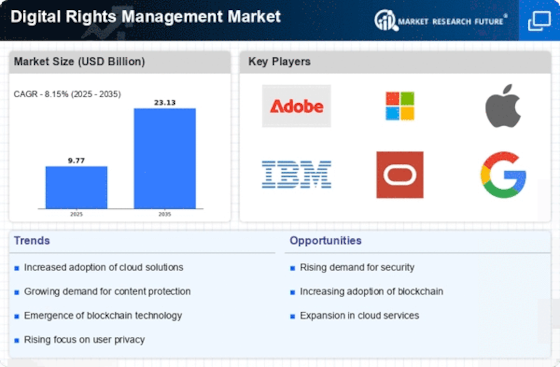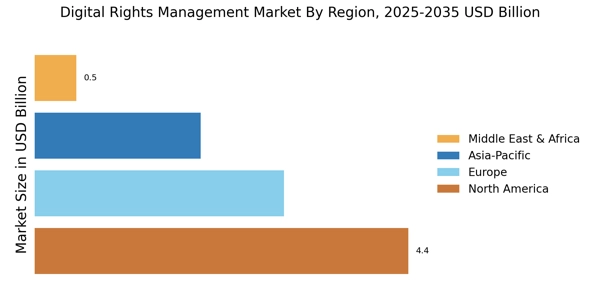Rise of Subscription-Based Models
The Digital Rights Management Market is witnessing a transformative shift towards subscription-based models across various sectors. This trend is particularly evident in the media and entertainment industries, where companies are increasingly offering subscription services for digital content access. By 2025, it is projected that subscription-based revenue models will contribute significantly to the overall market growth, potentially accounting for over 40% of total revenues. This shift necessitates robust DRM solutions to manage user access and protect content from unauthorized distribution. As businesses adapt to this model, the demand for effective DRM technologies is likely to escalate, indicating a promising outlook for the Digital Rights Management Market. The integration of DRM with subscription services not only enhances security but also improves user experience, thereby driving further adoption.
Increasing Demand for Content Protection
The Digital Rights Management Market experiences a notable surge in demand for content protection solutions. As digital content consumption rises, the need to safeguard intellectual property becomes paramount. In 2025, the market is projected to reach a valuation of approximately 5 billion USD, driven by the proliferation of streaming services and online content platforms. This trend indicates that businesses are increasingly investing in DRM technologies to prevent unauthorized access and piracy. The growing awareness of copyright infringement issues further propels this demand, as creators and publishers seek to maintain control over their digital assets. Consequently, the Digital Rights Management Market is likely to witness robust growth as organizations prioritize the implementation of effective content protection strategies.
Regulatory Compliance and Legal Frameworks
The Digital Rights Management Market is significantly influenced by evolving regulatory compliance and legal frameworks. Governments and regulatory bodies are increasingly enacting laws to protect intellectual property rights, which compels organizations to adopt DRM solutions. For instance, the implementation of stricter copyright laws and data protection regulations has created a pressing need for businesses to ensure compliance. In 2025, it is estimated that compliance-related investments in DRM technologies will account for a substantial portion of the market, potentially exceeding 30%. This trend suggests that organizations are not only motivated by the desire to protect their content but also by the necessity to adhere to legal requirements. As a result, the Digital Rights Management Market is poised for growth as companies seek to navigate the complex landscape of intellectual property rights.
Technological Advancements in DRM Solutions
The Digital Rights Management Market is propelled by continuous technological advancements in DRM solutions. Innovations such as blockchain technology and advanced encryption methods are enhancing the effectiveness of content protection strategies. In 2025, the market is expected to benefit from these advancements, with a projected growth rate of around 15% annually. The integration of artificial intelligence and machine learning into DRM systems is also gaining traction, enabling more sophisticated monitoring and enforcement of rights. These technological developments suggest that organizations are increasingly seeking cutting-edge solutions to address the challenges of digital piracy and unauthorized access. As a result, the Digital Rights Management Market is likely to evolve rapidly, with companies investing in state-of-the-art technologies to safeguard their digital assets.
Expansion of Digital Content Distribution Channels
The Digital Rights Management Market is significantly impacted by the expansion of digital content distribution channels. With the rise of various platforms, including social media, streaming services, and e-commerce sites, the need for effective DRM solutions has become more pronounced. In 2025, it is anticipated that the proliferation of these channels will drive a substantial increase in the demand for DRM technologies, potentially leading to a market growth of over 20%. This expansion presents both opportunities and challenges for content creators and distributors, as they must navigate the complexities of protecting their intellectual property across multiple platforms. Consequently, the Digital Rights Management Market is likely to see a surge in investments aimed at developing comprehensive DRM strategies that can adapt to the diverse landscape of digital content distribution.


















Leave a Comment